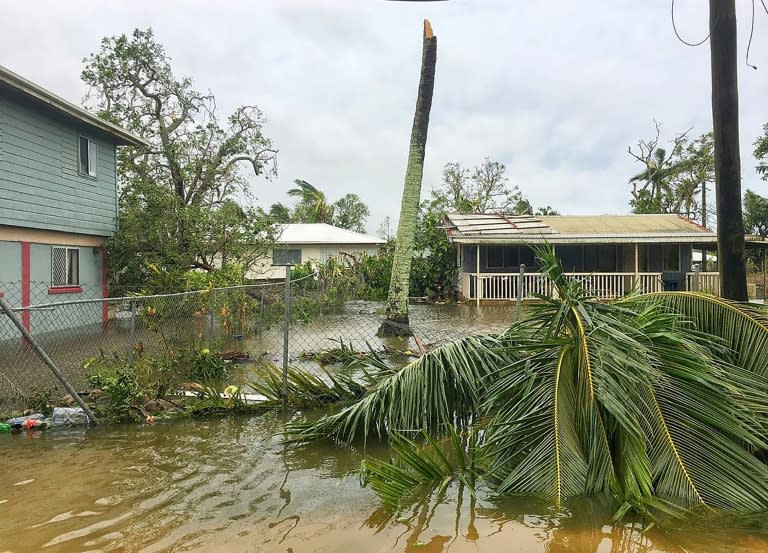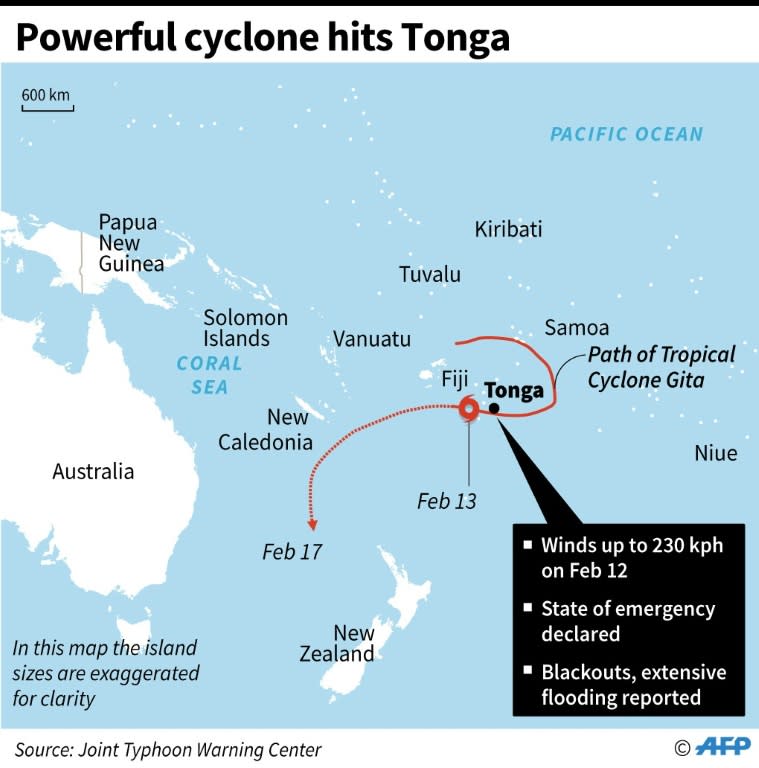Blackouts, flooding as cyclone batters Tongan capital
A battered Nuku'alofa began cleaning up Tuesday after the most powerful cyclone ever recorded in the Tongan capital tore roofs off buildings, downed powerlines and caused extensive flooding, prompting a state of emergency in the tiny Pacific nation. Veteran disaster management officials were shocked at the fury of Severe Cyclone Gita as it unleashed 230 kmh (142 mph) winds on Tonga's most populous island Tongatapu. Historic wooden buildings in the heart of Nuku'alofa, including parts of Tonga's parliament, were reduced to matchsticks as the tempest hit overnight. Broken power poles and trees blocked the roads and sheets of corrugated iron stripped from homes littered the capital. "It was a particularly bad night," Graham Kenna, from the National Emergency Office, told Radio New Zealand. "I've been involved in disaster response for 30-plus years and it was the worst situation I've been in." Even the Tongan Meteorological Service lost its roof, forcing it to hand over the job of issuing warnings about the cyclone to its counterpart in Fiji. Storm damage closed the international airport, along with the Australian High Commission, which warned its citizens against travelling to the devastated kingdom. Yet officials said it could have been worse. The storm did not reach a top-of-the-scale Category Five as feared and injuries were relatively light, with 33 people hospitalised, three of them seriously hurt. Police said a 72-year-old man suffered a fatal heart attack and the cyclone may have contributed to his death. Howling winds cut power to Tongatapu on Monday evening and peaked in the early hours of Tuesday as more than 3,000 people sheltered in evacuation centres. The military helped clear roads at first light, allowing clean-up teams to fan out and assess the extent of the destruction. "Someone's roof is in my front garden... some of the old landmark buildings that are 100 years old have been severely damaged by debris," Kenna said. In the midst of the storm, phone networks continued to operate and many of the 75,000 people on Tongatapu shared their experiences online. TVNZ's Pacific correspondent Barbara Dreaver said the cyclone sounded like "a screaming freight train". "Hotel is shaking and can hear screech of metal flying past outside ... rain water coming in sideways to second floor room," she tweeted. - 'Lengthy clean-up' - Lord Fusitu'a, a hereditary peer in Tonga's parliament, wrote: "I can literally feel my room shaking to the foundations -- it'll be a long night." As the cyclone moved out to sea early Tuesday, he said Nuku'alofa had experienced "a dose of miracle". "Astoundingly #TCGita seems to have subsided & we've avoided the worst of it," he wrote on Instagram. The storm had already created havoc when it slammed into Samoa on the weekend and authorities in Tonga declared a state of emergency before it hit. While there was widespread flooding, Kenna said the impact of storm surges on the flat terrain of Tongatapu was less than expected. It also passed just south of the capital rather than making a direct hit. But forecasters warned the threat from Gita was not over and it could still reach Category Five as it heads towards Fiji's remote and sparsely populated Ono-i-Lau island group early Wednesday. Philip Duncan, chief forecaster at New Zealand's Weather Watch service, said it could then brush Norfolk Island and New Caledonia before dissipating over New Zealand next week. New Zealand announced NZ$750,000 (US$544,000) in aid and deployed an air force plane to send supplies to Tonga. Australia sent a military plane carrying Aus$350,000 of emergency supplies, along with disaster response specialists. Cyclones are common in the Pacific at this time of year and Category Five systems have proved catastrophic when they make landfall. Cyclone Winston killed 44 people in Fiji in 2016, and Cyclone Pam claimed 11 lives and damaged 65,000 homes in Vanuatu in 2015.



